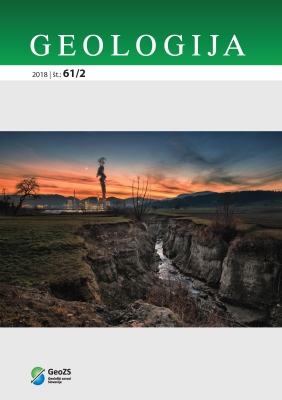Provenance and characteristics of the pavement stone from the courtyard of the Ljubljana Castle
DOI:
https://doi.org/10.5474/geologija.2018.018Abstract
The pavement stone used in the central courtyard of Ljubljana Castle originates from the Kukul area northeast of the town of Prilep in Republic of Macedonia. Several pavers were badly damaged and partly replaced by two other natural stones, because the original stone from Kukul is no longer available on the market. The natural stone that is recently used as a replacement is commercially named “Bianco Sardo” and differs from original rock from Kukul in both, structure and composition. The advancement of the replacement of original pavers with “Bianco Sardo” is resulting in extremely uneven and disturbing appearance of the courtyard. The original Kukul stone used in the central courtyard of Ljubljana Castle is of metamorphic origin and belongs to gneisses. Two types of pavers were identified, the light coloured and the dark coloured varieties. They have similar mineral composition consisting of quartz, feldspars (orthoclase, microcline and plagioclases), minerals of the epidote group, micas (muscovite and biotite), titanite, zircon, clinopyroxene, kyanite, pyrite and calcite. Light coloured pavers have porphyroclastic, protomylonitic to mylonitic structures. Dark coloured pavers display gneissic structure, contain more quartz and epidote, less feldspars, and no clinopyroxene. They show intensive recrystallization and granoblastic textures. Both analysed rock types belong to the same rock massif, only that the blocks were extracted from various parts of the rock massif. The variations are due to the process of metamorphic differentiation, which resulted in segregation and separation of light and dark coloured minerals. In the past, the natural stone that was coming from Kukul, was known and classifyed as a type of granite. The rock that is used in the central courtyard of Ljubljana Castle is not granite but granitic gneiss, therefore, we assume that in the last stages of quarrying in the Prilep area, they were extracting also the metamorphic country rocks for some time. The broader area of Prilep belongs to the Pelagonian massif. Its thick metamorphic complex contains also granitoid (granodiorite) intrusives, which crop out in the Prilep anticline and used to be quarried at the locality of Kukul. According to national regulations of the Republic of Macedonia the area is now protected as a natural monument and further exploitation was no longer possible. Today, there is only one open granite exploitation field in the wider surroundings of Prilep, the locality of Lozjanska Reka–Kruševica and a few localities of gneiss-granites of high potential. It would be necessary to consider these solutions for the conservation-restoration of the Ljubljana Castle central courtyard instead of using an inappropriate stone replacement.Downloads
How to Cite
Peulič, K., Novak, M., & Vrabec, M. (2018). Provenance and characteristics of the pavement stone from the courtyard of the Ljubljana Castle. Geologija, 61(2), 253–266. https://doi.org/10.5474/geologija.2018.018
Issue
Section
Articles

